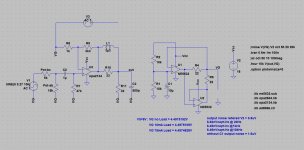You might want to take a look at AMB's mini^3 DIY headphone amp, if you haven't already. It uses a Hammond 1455 case and includes a virtual ground on the PC board:
The Mini³ portable stereo headphone amplifier
I've seen it, but i'd need to order a PCB from AMB, right? I don't think they've got the PCB files released. I really don't want to order a PCB from the USA and wait a month for it to get here.
cheers
Yes, these buffer chips are recommended for such use, but they cost much more than TLE2426 and according to Tangent's website, they would introduce higher output impedance, and higher battery draw. Not to mention the availability is a problem, again.
They are both designed to drive headphones so I think they would be superior. They are expensive. I've ordered both from Digikey within the last year. They also both have adjustable bias current although neither is ideal for battery use. An appropriate op amp would be better for battery use.
If the main point is gaining some experience, why not just go classic single-supply AC-coupled? Two 470µ/10-16V or so output coupling caps should still be smaller than an additional 9V block, and a filtered resistive voltage divider (R-R||C) should be quite sufficient for +Vs/2 generation then - especially when going inverting.
NE5534P (that should be the TI part, right?) has a decent amount of "oomph" and fairly low internal output impedance, and it's supposed to work from +/-3 V up, so it's quite well-suited for a circuit like this. Do not forget the compensation capacitor though, and I would also recommend maybe 10 ohms (or 15 or 22) of output series resistance outside the feedback loop for better stability into capacitive loads (like headphone cables). ATH-M50s aren't too fussy about output impedance.
If space is at a premium, one NE5532 may be a better option than two 5534s, btw - but be warned that TI's part is only guaranteed for +/-5 V (10 V) up for some reason.
NE5534P (that should be the TI part, right?) has a decent amount of "oomph" and fairly low internal output impedance, and it's supposed to work from +/-3 V up, so it's quite well-suited for a circuit like this. Do not forget the compensation capacitor though, and I would also recommend maybe 10 ohms (or 15 or 22) of output series resistance outside the feedback loop for better stability into capacitive loads (like headphone cables). ATH-M50s aren't too fussy about output impedance.
If space is at a premium, one NE5532 may be a better option than two 5534s, btw - but be warned that TI's part is only guaranteed for +/-5 V (10 V) up for some reason.
This is just my opinion, so take it with a grain of salt. I believe that people who are diving into this subject (or EE in general) should avoid bad designs and bad habits from the start at all costs. Why would you waste your money, any amount, building a bad, sub-standard circuit? I completely agree with the guy who said that 2 9V batteries is a FAR better solution than any virtual ground you will build. Or better yet, an LM317 and LM337 are not that expensive these days. Do it right and build a proper dual supply. Set your habits to be good ones from the start and get in the habit of building good circuits.
If you build the PSU separate from the rest of the headphone amp, you can reuse it for any other amps you build as well. That's what I did when I was first starting out to save money and time. I'm glad I read the Tangent articles, but at the end of the day, I'm glad I chose to build amps the right way from the get-go. The results have been much better because of it.
If you build the PSU separate from the rest of the headphone amp, you can reuse it for any other amps you build as well. That's what I did when I was first starting out to save money and time. I'm glad I read the Tangent articles, but at the end of the day, I'm glad I chose to build amps the right way from the get-go. The results have been much better because of it.
- Status
- Not open for further replies.
